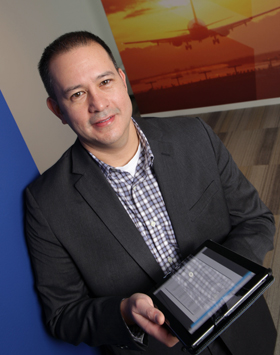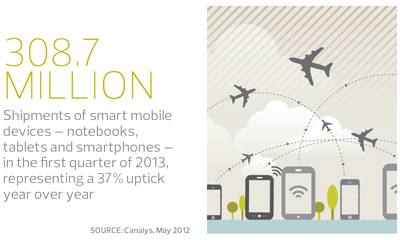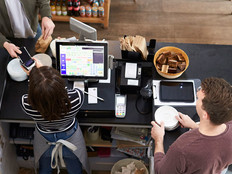United Airlines and GE Make Room for Mobility
It’s no secret that mobility is reinventing how most offices — whether at a Fortune 500 company, a small startup, a government agency or a university campus — function and conduct day-to-day business.
The explosion of tablets, smartphones and ultraportable notebooks over the last few years is bringing anywhere, anytime information access to conference rooms, shop floors, field service vehicles, classrooms and scores of other locations. So what’s different now? It’s how the success of early mobility is paving the way for new and potentially more transformative uses of these tools.
A case in point is United Airlines, one of the world’s oldest and largest air carriers. By outfitting its 12,000 pilots with Apple iPad devices, the company mothballed traditional 50-pound satchels of essential flight charts and other documentation. The lightened loads save more than $1 million a year in fuel and printing costs. The airline is now considering how to deploy tablets to enhance customer service.
“The further we move into a more mobile world, the closer we are looking at how we operate as an enterprise and where we can get more bang for the buck out of these devices,” says Jon Merritt, senior manager of flight operations and technology for United.
General Electric, another long-time business icon, is also exploring how mobile-enabled information sharing and collaboration in manufacturing plants yields greater efficiency and new opportunities for reducing waste.
“Productivity gains will be insane when people automatically receive the information they need when they need it, versus having to sit in front of a monitor searching for it,” says Mark Bernardo, general manager of automation software for GE Intelligent Platforms. “We see that as a game changer, so that’s where we’re focusing our attention.”
As United, GE and scores of other mobile innovators gather hard data about the payoff of their initiatives, they are also gaining insights into the unanticipated challenges that crop up during their technology implementations. In the process, they are sharing valuable lessons about how to succeed in the mobile future as both best practices and mobile technology continue to evolve at a blistering pace.
Tablets Take Flight
United Airlines has a unique perspective on the appeal and potential of current and next-generation mobile solutions. Its mobile strategy over the past five years demonstrated how tablets not only help keep pilots connected while on the move, but also can reduce costs and improve services.
The lightweight and trim profile of the iPad devices that pilots now carry is a welcome alternative to the flight bags the devices replaced. Traditionally, a pilot toted a hulking 40- to 50-pound case on every trip. Inside were stacks of paper manuals with essential reference material, such as charts, manuals and various procedures that would be required throughout the flight. Because every airline must regularly revise this information, United had to distribute updates every two to four weeks, which meant it had to pay for printing approximately 16 million pages of documentation a year.

Photo: Paul S. Howell
“We are constantly trying to improve customer experience,” says United's Jon Merritt.
About seven years ago, Capt. Joe Burns, United’s managing director of technology and flight test, launched a drive to move from these physical bags to digital ones. Digital avionics equipment helped somewhat, but these special-purpose devices came with price tags of between $50,000 and $100,000 each, depending on the model.
“About five years ago we saw an opportunity, thanks to the price point of tablets, to move away from the dedicated avionics equipment,” Merritt says.
The United team also determined that the latest generations of tablet technology were reliable enough to successfully take over this critical element of flight operations, he adds.
Since the adoption of iPad devices by flight crews, the airline has logged significant benefits. First, by eliminating the weight of a conventional flight bag for each pilot, the airline trimmed fuel consumption — by about 326,000 gallons each year, Merritt estimates. With fuel prices hovering around $3 per gallon, that’s almost $1 million in annual savings alone.
Reducing paper requirements resulted in further cost and environmental advantages. “We eliminated not only the cost of printing the documents, but also the expenses associated with shipping all that paper to our pilots,” he says.
Merritt and his group are now looking for new mobile opportunities. “We are constantly trying to improve customer experience,” he adds.
One possibility? United may send more information to cockpit tablets that pilots in turn can pass along to passengers.
“We may send real-time weather reports or other important updates, such as who just scored a run in an important baseball game since the airplane took off,” he says.
Collaboration on Shop Floors
At GE, supervisory control and data acquisition (SCADA) systems for industrial plants enable real-time monitoring of equipment and processes, providing insights for everyone from equipment operators on shop floors and quality control personnel to the maintenance staff and managers in central control rooms. When the company’s staff discussed what innovations should be included in next-generation SCADA technology, employees identified four important trends: sophisticated real-time analytics, enhanced security, new collaboration tools and mobility.
“Mobility was the first area we attacked because we felt that it would drive the most immediate productivity for our users,” Bernardo says.
GE mobilized its current SCADA applications so tablets could display the performance data and status updates that were traditionally available only on PCs. “That unleashed people from being chained to a control room or a production line,” he says.
The advantages quickly became apparent. By giving facilities managers and production personnel easy access to real-time information, they are able to collaborate more effectively.
“Their ability to solve problems went up dramatically,” Bernardo says.
For example, if the temperature rises unexpectedly in an industrial oven, people on the shop floor can meet the maintenance staff and a control room supervisor at the site of the problem and determine the cause and a solution. “It’s a level of collaboration you don’t have when one guy is in a control room three floors higher than the operator and your maintenance person is in the next building,” Bernardo says.
Many GE customers report cost savings of 20 percent or more from the new mobility features, he says. Reducing waste is one way that mobility is achieving a return on investment. “When you equip people with mobile technology, you can dramatically shrink the delta between when a problem occurs and when it’s acted upon,” Bernardo says. “If there’s a quality control problem in a production line, they can shut down the line before it continues to create products that will all be waste.”
GE not only hears positive feedback from customers who buy the SCADA systems, it experiences the results first hand in its own production facilities.
The mobile components in current SCADA solutions are pointing the way to future innovations. The ongoing goal will be to deliver critical information tailored to specific needs of supervisors and production workers, without forcing them to wade through data that isn’t relevant to their individual responsibilities.
Bernardo also envisions greater use of location-aware apps. For instance, if a pump station for a municipal wastewater facility starts to fail, all relevant information to the specific pump would automatically pop up on a tablet carried by a field technician. “He wouldn’t even need to search for it; he’ll immediately know how to fix the unit.”
Building a Long-Term Roadmap for Mobility
As mobile pioneers document ROI, they are also learning how to assure future success. One chief challenge for organizations is addressing the fast pace of mobile innovation. Both United and GE officials note that embracing mobility includes coping with a highly dynamic market.
Merritt suggests that organizations resist the temptation to continuously revise their mobile plans every time a manufacturer introduces new hardware features. Carefully defining and sticking to the goals of the current mobility project can help overcome gadget cravings, he says.
“If you don’t have goals etched in stone, you run the risk of scope creep — one more feature, one more feature and one more feature,” Merritt says. “If you do that, you may never fully realize the cost benefits and savings that go along with these projects.”
But that doesn’t mean organizations should ignore innovation, Bernardo adds. Instead, IT teams should develop long-term mobile roadmaps that anticipate and plan for future advances and how the organization will accommodate them.

“Consider what will be your biggest challenges over the next three years and what opportunities will be available to address those challenges,” he advises. “Then make sure your mobile strategy incorporates the types of technology, capabilities and products that will support those opportunities.”
Finally, IT managers should focus on end users and their roles, not solely on technology, says Dilip Bhatia, vice president and general manager of Lenovo’s ThinkPad Business Unit.
“Some of the most forward looking and successful organizations approach mobility by analyzing their end users,” Bhatia says. “They understand the usage models within their enterprises — who is the global traveler, who sits at their desk, what resources the manufacturing employee needs, what tools the person at the front desk needs. Once they have a clear picture of these individual requirements, they can determine whether these people have the right devices, the right apps, the right services.”
Help with Mobile App Development
Mobile applications present some unique programming challenges. That means even if an organization has a deep developer bench, it may need an outside assist.
Third-party mobile app developers offer a combination of programming and training services. Therefore, decision-makers can quickly create a mobile app and also teach staffers the intricacies of this discipline.
“We partner with them so that they can actually see how we are doing it,” says Will Scott, president of custom mobile app developer Lextech Global Services. “And eventually they are able to bring some of that competence in house.”
Mobile products provider Xtreme Labs’ core development methodology is pair programming, where two engineers work together to build a mobile product. It provides its customers with a similar service, matching one of its engineers with a client engineer. Together, they create a mobile product on one computer using two keyboards and two mice.
But what if an app fails? There’s Lextech’s Rescue My App. “If a customer wrote an app in house only to find it was getting bad reviews in the store, we can fix it,” Scott says.








